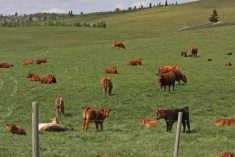Researchers have found an easy way to test for pesticide toxins in food.
Scientists with the Sentinel Research Network have developed strips of bioactive paper that can test the concentration of toxins.
“We don’t need any sophisticated equipment at all, we don’t need any electricity at all,” said John Brennan, a member of Sentinel and professor with McMaster University’s chemistry department.
“We can basically take something, whether it’s a food or whether it’s a liquid … put the test strip in and in five minutes you’ve got a colour that you can then compare to a colour chart, essentially, and get a sense of what your concentration of pesticide is.”
Read Also

Know what costs are involved in keeping crops in the bin
When you’re looking at full bins and rising calf prices, the human reflex is to hold on and hope for more. That’s not a plan. It’s a bet. Storage has a price tag.
The test strips work by using enzymes printed onto the paper with an inkjet printer.
Brennan said the strips have two zones: the dipping zone that contains reagents and the sensing zone that contains enzymes.
When the strip is dipped into water or another liquid, the water runs up the paper and takes the reagents with it. If the water doesn’t contain a toxin, the reagents will react with the enzyme, creating a blue colour.
Other molecules within the enzyme zone capture the blue colouring, creating a blue line.
“So if your water has a pesticide in it, what will happen is the pesticide will bind to the enzyme and shut it down,” Brennan said. The blue line does not appear if that happens.
The strips only test for pesticide toxins, but Brennan said researchers also want to develop test strips for other substances.
“We’re now working on a whole range of other sensing technologies, including sensors for E. coli and other pathogenic bacteria, different types of toxins.”
Part of the motivation for this additional research stems from the interest of outside companies.
Brennan said many have contacted researchers to find out if the strips can detect particular substances.
Others have requested access to the strips.
“We’ve had a lot of interest from companies that supply the military with test strips and sensors, as well as the agricultural and food safety community.”
Brennan said the group is working to commercialize the strips for food safety uses, although it will probably be at least three years before they’re on the market.
The delay comes from regulation setbacks. Before the strips can be used for food safety, they need to be validated by a third party and gain Health Canada approval.
However, Brennan said moving into the agricultural sector would easier.
“One of the areas that we’ve been looking at is simply testing feed stocks for animals to make sure they’re not ingesting the pesticides to begin with.”
He said most pesticides and other toxins are water soluble, which means someone wishing to test a food item would only need to wash that item and test the liquid residue.
The research network was formed in 2005 and is made up of university professors and students. It works with the federal and Ontario governments and corporate partners.
The network is also working to develop other bioactive papers.














